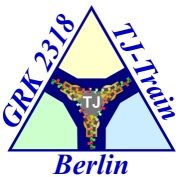
DFG Research Training Group "TJ-Train" (GRK 2318/2)
Tight junctions and their proteins
Molecular features and actions in health and disease
Project A3, 3rd cohort:
Functional-structural
relationship of paracellular channels formed by claudin-10b and claudin-15
State of the art: Claudins are tetraspan membrane proteins of the bicellular tight
junction (TJ) that form a paracellular barrier against solutes and water passage across epithelia. However, a subset of claudins not only build a barrier against large molecules but also form
paracellular channels through the tight junction. Of these, claudin-10b and claudin-15 form cation-selective homo-polymeric channels. They differ in permeability for various cations depending
on their re-spective size and hydration shell (Eisenman sequence) as well as for water. These differences result in specific transport functions, for instance in kidney tubules mutations of
claudin-10b lead to diseases caused by altered reabsorption, and in small intestine loss of claudin-15 leads to malabsorption. The channel structure of claudins is yet unknown, although models
of their molecular architecture have been suggested based on the claudin-15 crystal structure. The amino acids of the extracellular segments that are widely conserved between claudin-10b and
claudin-15 have been shown to be critical for charge selectivity.
Aims: Clarifying the molecular determinants of cation and water channel function for claudin-10b and claudin-15.
Hypotheses: The permeability properties of claudin-10b and of claudin-15 channels are determined by specific sequence differences in their extracellular segments.
Methods: Mutagenesis, culture of epithelial cell clones, transfection, immunostaining, confocal and STED microscopy, dilution potentials, water transport, and structural bioinformatics.
Thesis project: We will study molecular determinants regulating the function of claudin-10b and -15 channels. Comparison of molecular models of claudin-10b and -15 channels are used to
select regions and individual pore-lining amino acid residues in the extracellular domain that differ between both. Candidate chimeric mutations predicted to convert one claudin functionally
into the other claudin (Eisenman sequence, water permeability) will be designed, generated by site-directed mutagenesis and stably expressed in epithelial cell lines with different claudin
back-ground (MDCK-C7 with, quinKO MDCKII without endogenous TJs). Cell membrane transport and TJ incorporation will be tested by immunostaining (claudin mutant, TJ markers), confocal and STED
microscopy. Mutants lacking TJ localization provide information about claudin polymer assembly. Mutants with TJ localization will be further analyzed functionally: Barrier formation against
small and large molecule permeation by tracer flux assays; selective ion channel formation by electrophysiology and water transport assays. Iterative combination of (i) channel structure
modelling, (ii) candidate mutant selection, (iii) mutant generation/testing, and (iv) evaluation concerning model consistency will be performed.
3rd cohort PhD doctoral student
Alina Handreg


2nd cohort PhD doctoral student
Fabián Martínez-Perafán


1st cohort PhD doctoral student
Carlos Ayala-Torres


29.04.21: Doctoral examination passed, Dr. rer. nat. (PhD), Freie Universität Berlin,
magna cum laude
-
Ayala-Torres C, Krug SM, Rosenthal R*, Fromm M* (*shared last authorship) (2021)
Angulin-1 (LSR) affects paracellular water transport, however only in tight epithelial cells. Int. J. Mol. Sci.
22: 7827 (25 pages).
doi: 10.3390/ijms22157827 (IF 6.2)
-
Ayala-Torres C, Krug SM, Schulzke JD, Rosenthal R*, Fromm M* (*shared last authorship) (2019)
Tricellulin effect on paracellular water transport. Int. J. Mol. Sci.
20 (22): 5700 (15 pages) [PubMed]
[WebPage] [PDF]
(IF 4.6)
-
Rosenthal R, Günzel D, Piontek J, Krug SM,
Ayala-Torres C, Hempel C, Theune D, Fromm M
(2020) Claudin-15 forms a water channel through the tight junction with distinct function compared to claudin-2.
Acta Physiol.
228(1): e13334 (15 pages)
[PubMed] [WebPage]
[PDF]
(°IF 6.3)
Participation with project
A3
Priv.-Doz. Dr. Rita
Rosenthal


Priv.-Doz. Dr. Susanne M. Krug


Project-related publications
If a paper is not accessible, please mail to
 . .
-
Piontek J, Krug SM, Protze J, Krause G,
Fromm M (2020) Molecular architecture and assembly of the tight junction backbone.
BBA Biomembranes
1862(7): 183279 (15 pages) [PubMed] [WebPage] [PDF]
[Supplement]
(Review)
-
Rosenthal
R, Czichos C, Theune D, Günzel D, Schulzke JD, Fromm M (2017) Water channels and barriers formed by claudins.
Ann. N.Y. Acad. Sci.
1397: 100-109
[PubMed]
[WebPage] [PDF]
(Review)
-
Fromm M, Piontek J, Rosenthal R, Günzel D, Krug SM (2017) Tight
junctions of the proximal tubule and their channel proteins.
Pflügers Arch.
469(7-8): 877-887 [PubMed] [WebPage]
[PDF]
(Review)
-
Rosenthal
R, Günzel D, Krug SM, Schulzke JD, Fromm M, Yu ASL (2017) Claudin-2-mediated cation and water transport share a
common pore. Acta Physiol.
219(2): 521-536
[PubMed] [WebPage]
[PDF]
-
Milatz S, Krug SM, Rosenthal R, Günzel D,
Müller D, Schulzke JD, Amasheh S*, Fromm M* (*shared last authorship) (2010) Claudin-3 acts as a sealing
component of the tight junction for ions of either charge and uncharged solutes.
Biochim. Biophys. Acta Biomembr. 1798: 2048-2057
-
Milatz S, Piontek J, Schulzke JD, Blasig IE,
Fromm M, Günzel D (2015) Probing the cis-arrangement of prototype tight junction proteins claudin-1 and
claudin-3. Biochem. J. 468(3): 449-458
-
Rosenthal R,
Milatz S, Krug SM, Oelrich B, Schulzke JD, Amasheh S, Günzel D, Fromm M (2010) Claudin-2, a component of the
tight junction, forms a paracellular water channel.
J. Cell Sci. 123(11): 1913-1921 [PubMed]
[WebPage] [PDF]
[Supplement]
-
Krug SM, Fromm M, Günzel D (2009) Two-path
impedance spectroscopy for measuring paracellular and transcellular epithelial resistance.
Biophys. J.
97(8): 2202-2211 [PubMed]
[WebPage] [PDF]
[Supplement]
-
Yu ASL, Cheng MH, Angelow S, Günzel D, Kanzawa
SA, Schneeberger EE, Fromm M, Coalson RD (2009) Molecular basis for cation selectivity in claudin-2-based
paracellular pores: Identification of an electrostatic interaction site. J. Gen.
Physiol. 133(1): 111-127 [PubMed] [WebPage]
[PDF]
-
Amasheh S, Meiri N,
Gitter AH, Schöneberg T, Mankertz J, Schulzke JD, Fromm M (2002) Claudin-2 expression induces cation-selective
channels in tight junctions of epithelial cells.
J. Cell Sci. 115(24): 4969-4976 [PubMed]
[WebPage] [PDF]
|
